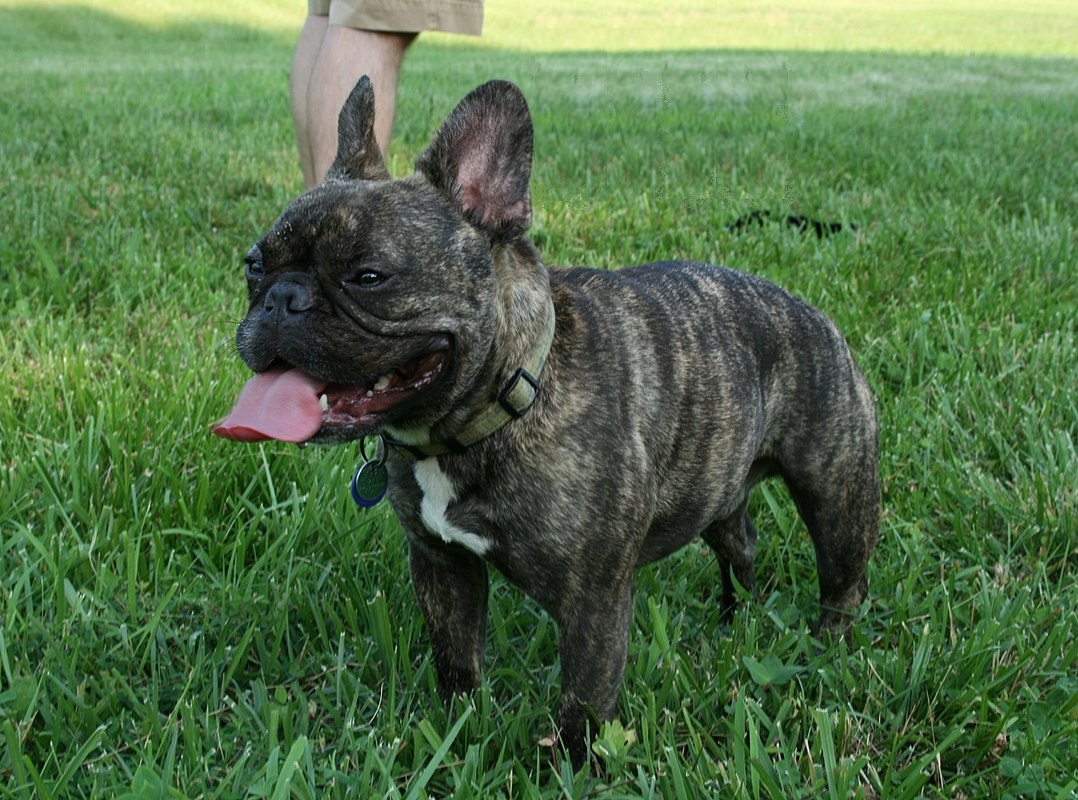It’s no longer a secret that French Bulldogs come in various colors and patterns.
But have you met the captivating brindle French Bulldog?
And it does not end there.
The stunning coat pattern comes in different variations.
Want to know more about it?
Come with us as we tell you all you need about the brindle French Bulldog.
What’s a Brindle French Bulldog?

Source: Wikicommons
Irregular light streaks mark a brindle French Bulldog over a darker base coat. The brindle pattern usually displays a lovely light shade of fawn, while the base coat comes in various colors such as standard black and lilac, blue, or chocolate. A brindle French Bulldog is often referred to as the tiger-striped Frenchie.
Breed Overview
The table below gives an overview of the brindle French Bulldog breed.
| Fawn French Bulldog | Description |
| Other names | Tiger-striped Frenchie |
| Purity | Purebred |
| Size | Small |
| Height | 11-13 inches |
| Weight | 17-28 pounds |
| Purpose | Companion dog |
| AKC recognition | Yes |
| Coat Type | Short, smooth |
| Family Compatibility | High |
| Coat color | Light brown, red |
| Pet friendliness | Moderate |
| Child friendliness | High |
| Barking level | Low |
| Shedding level | Moderate |
| Grooming needs | Moderate |
| Trainability | Moderate |
| Energy level | Moderate |
| Exercise needs | Low |
| Hypoallergenic | No |
| Life span | 10-12 years |
| Litter size | 2-4 puppies |
| Puppy costs | $1500-$ |
Are brindle French Bulldogs purebred?
Yes, Brindle Frenchies are purebred. Brindle is among the nine coat colors and patterns accepted by AKC as a standard color for Frenchies. Brindle Frenchies can thus take part in AKC shows.
Where does the brindle color come from?
Its parents’ genes influence a Frenchie’s coat color—the French Bulldog’s brindle color results from its genetic makeup. The color is caused by a recessive gene found in the K-locus. This gene is responsible for the dominant black, fawn, and brindle colors. A Frenchie must inherit the recessive K gene from both parents to have the brindle coat color.
Other genes contribute to the brindle coat pattern; hence each brindle Frenchie is unique. While some will display the brindle pattern all over their bodies, others will show it only in specific areas.
Origin

The brindle Frenchie shares the same history as any other French Bulldog. Frenchie’s origin can be traced back to England in the 1800s. These dogs were descendants of the English Bulldog initially used for Bullbaiting. When bullbaiting was later banned in 1835, these bulldogs were left without work.
To save the bulldogs, the English breeders began breeding them with smaller dogs to create smaller versions of the Bulldog. These small dogs became popular among the lacemakers who lived in Nottingham.
The lacemakers brought their little dogs when they moved to Northern France following the industrial revolution. In the French countryside, these dogs were eventually bred with local Parisian matters giving rise to the French Bulldog we know today.
The French Bulldogs were later brought to the United States in the late 1900s, where they gained popularity as well.
Top 5 Unique Facts About Brindle French Bulldogs
The following are some facts about brindle Frenchies that you should know:
- They can’t swim: Because of their body structure that’s marked by large heads, short necks and muzzles, and short legs, brindle Frenchies, just like all other Frenchies, are unable to float in water for a long time. This makes them highly likely to drown in water.
- They are good watchdogs: Despite their small size and low barking tendencies, brindle Frenchies make excellent watchdogs. They are wary of strangers and quickly alert you of unusual happenings.
- The brindle pattern results from a recessive gene: The unique brindle coat color pattern results from a recessive gene found in the K-locus. For a Frenchie to have this pattern, it must inherit the recessive K gene from both of its parents.
- Brindle Frenchies can’t reproduce naturally: Just like regular Frenchies, brindle Frenchies cannot give birth naturally due to their small hips. They can only reproduce via artificial insemination and cesarean section.
- They are clingy: Like the regular French Bulldog, brindle Frenchies love spending time with their owners. This dog loves cuddling in bed and will follow you wherever you go. These Frenchies can’t handle being left alone as they are prone to separation anxiety.
What Makes a Brindle French Bulldog?

The brindle coat color pattern is a result of a recessive gene that’s found in the K-locus. Since it’s a recessive gene, a Frenchie must inherit the gene from both parents to display the brindle pattern.
Brindle French Bulldog DNA
The brindle gene is denoted as Kbr. For a Frenchie to have the brindle coat pattern, it must have two copies of the brindle gene, denoted as Kbr/Kbr. A French Bulldog with a single copy of the brindle gene will be shown as Kbr/Ky. This Frenchie will be a carrier but will not display the brindle coat color.
How Many Types of Brindle Frenchies Are There?

Brindle Frenchies come in multiple variations, which include:
Reverse Brindle French Bulldogs
Reverse brindle Frenchies have a white or cream coat with dark patches or stripes. These types of Frenchies are considered the rarest.
Blue Brindle French Bulldogs
Blue brindle Frenchies have a grayish-blue coat with some brindle striping. The gene also dilutes the color of the blue brindle Frenchie’s nose, making it gray or blue.
Pied Brindle French Bulldog
These Frenchies are similar to reverse brindles but have fewer dark patches. Pied brindles also have at least one patch around their eyes.
Chocolate Brindle French Bulldogs
These come in a mixture of brown and a milky color. Chocolate brindles also have brown noses and nails, plus blue eyes.
Tiger Brindle French Bulldogs
As the name suggests, tiger brindle Frenchies have dark-colored coats with fine white hairs that form tiger-like stripes.
Seal Brindle French Bulldogs
Seal brindles have darker coats that are mixed with fewer light colors. These bulldogs are mistaken for one-color dogs since these lighter hairs are hardly noticeable.
Why are there so many brindle variations?
There are several variations of brindle which are determined by the intensity locus. This determines the effect on the red pigment (phaeomelanin) and the black pigment (eumelanin).
Can black French Bulldogs turn brindle?
No, a black Frenchie can’t turn brindle. This is because black Frenchies have a dominant black gene. This gene dominates over the brindle gene; hence only the black color will be displayed. The brindle gene is inferior to black.
Physical Characteristics of Brindle French Bulldogs
Besides their unique coat color, brindle Frenchies look similar to any other French Bulldog. They are compact, muscular dogs with bat-like ears, large square heads, and squished facial appearance. They also have short noses, loose jowls, short, straight tails, powerful jaws, and muscular necks.
A brindle Frenchie also has a straight back with a tucked-in appearance. Its face is marked with heavy wrinkles and folds. This pup has large expressive eyes that are dark-rimmed.
The Temperament of a Brindle French Bulldog
Like the regular French Bulldog, Brindle Frenchies are friendly, affectionate, and social dogs that make excellent family pets. They are also gentle and playful, making them great companions for children. They get along with people of all ages and other dogs and pets.
Brindle French Bulldogs are also highly adaptable and adapt well to different situations and households. While smart, these dogs have a stubborn streak, making training challenging.
Health Issues With a Brindle French Bulldog
Although they are adorable dogs, brindle Frenchies are prone to various genetic health issues, similar to any other French Bulldog. This is mainly due to their brachycephalic structure. The following are some of the health challenges that a brindle Frenchie can have:
- Von Willebrand’s disease: is when blood takes an abnormally long time to clot, leading to excessive bleeding.
- Brachycephalic airway syndrome: refers to a particular set of upper airway abnormalities, such as elongated soft palate, stenotic nares, and laryngeal collapse. This results in respiratory and breathing problems.
- Patella luxation: Brindle Frenchies are prone to patellar luxation, a condition that involves the dislocation of kneecaps. This condition causes pain, instability, immobility, and lameness. It can also lead to ligament destruction and other serious issues.
- Hip dysplasia is a condition in which the hip joint is malformed and does not function as it should. The condition results in pain, arthritis, and partial immobility.
- Allergies: Brindle Frenchies are prone to allergies, just like other Frenchies. A Frenchie with allergies will exhibit itchy skin, runny nose, sneezing, constant scratching, and paw licking.
- Cherry eye: This condition occurs when a dog’s third eyelid gets weakened, resulting in a prolapse. This condition is extremely uncomfortable and painful and can lead to other complications like conjunctivitis or corneal ulcers. The symptoms of cherry eye include swelling and a small red protrusion on the eyelid.
- Hemivertebrae: This condition causes an abnormality in the spine resulting in a lot of pain and possible paralysis.
Training & Exercise Needs of Brindle French Bulldog
Brindle Frenchies are smart dogs which makes them easy to train. However, these dogs also have a stubborn streak, making training challenging. It’s thus best to start training them early. They can quickly grasp instructions and commands using the right training techniques.
Frenchies generally respond best to positive reinforcement training techniques such as words of encouragement and reward-based training. You’ll also need to be patient and consistent in your training. Remember to keep the training sessions short and entertaining, as Frenchies easily get bored.
Brindle Frenchies have moderate energy levels and thus don’t require much exercise to keep them active. Ideally, one hour of low-intensity daily exercise split into two sessions is sufficient to keep these dogs healthy and fit. Since they are brachycephalic dogs, you should avoid exercising them in warmer climates, which may lead to breathing problems. A daily stroll and an outdoor play session are sufficient for these dogs.
Brindle French Bulldog Names Ideas
The following are some popular names for brindle French Bulldogs:
Female Brindles
- Luna
- Zoe
- Bella
- Coco
- Lola
- Lucy
- Stella
Male Brindles
- Leo
- Milo
- Bruno
- Gus
- Louie
- Oliver
- Rocky
- Winstone
- Frankie
Feeding and Nutrition Requirements for Brindle French Bulldog

Brindle Frenchies, just like other Frenchies, have highly sensitive stomachs and are prone to food allergies. It’s thus crucial to be careful about the type of food that you give your Frenchie. These Frenchies need a high-quality and completely balanced diet to thrive.
The ideal food should be nutrient-dense and made using natural ingredients. It should be high in protein and fiber but low in carbs, fats, and salt. Avoid any food with fillers and artificial preservatives, as these contribute to obesity.
Like other Frenchies, Brindle Frenchies are prone to unhealthy weight gain and obesity which can result in serious health problems. It’s, therefore, important to monitor your dog’s food intake by giving the right proportions. Grey French puppies need 1-1 ½ cups of food split into 3 meals per day, while adults can have up to cups of food portioned into two meals daily.
Grooming and Maintenance of Brindle French Bulldogs
Due to their short fine coats, brindle Frenchies are easy to groom. These dogs only require weekly brushing to prevent their hair from matting and keep loose hair at bay. Regular coat brushing will help redistribute body oils throughout the coat, keeping it healthy and shiny.
Brindle Frenchies don’t need frequent bathing. You’ll only need to bathe 4-5 times yearly or whenever it gets into a mess, like rolling in mud or anything sticky.
While it does not need to be bathed regularly, the brindle French Bulldog has skin folds that must be cleaned and dried daily to keep them from infections. Remember to trim your Frenchie’s nails monthly to avoid discomfort or overgrowth.
What Is the Cost of a Brindle French Bulldog Dog
The cost of a brindle French Bulldog will depend on factors like the breeder’s location, reputation, lineage, and age. However, you can expect to pay between $1,500 and $ 3,000. Brindle Frenchies from exceptional lineage or with a rare or unique coloring can cost up to $8,800.
Frenchies are generally expensive compared to other breeds due to their difficulty in breeding. They often need artificial insemination and a cesarean section to give birth. Remember to factor in other costs involved in owning a Frenchie, such as vet bills, food costs, toys, and grooming costs.
How Can I Find a Brindle French Bulldog?
You can purchase a brindle Frenchie from a breeder or adopt it from a rescue home. Generally, adopting from a rescue center is much cheaper than buying from a breeder.
Purchase from a Breeder
If you decide to purchase your brindle Frenchie from a breeder, ensure you look for a reputable breeder who will give you a health guarantee for their dogs. Any ethical and reputable breeder has the health records of their puppies available and won’t hesitate to provide them if requested.
The following are some of the major brindle Frenchie breeders available:
| Breeder | Contacts |
| Francoeur Frenchies( California) | Website: www.francouerfrenchies.com |
| Unique French Bulldogs(Australia) | Website: www.uniquefrenchbulldogs.com |
| Canadian Frenchies (Canada) | Website: www.canadianfrenchies.ca/nursery |
| TomKings Kennel (UK) | Website:www.tomkingskennel.com |
| Wild Blue French Bulldogs (Dallas) | website:wildbluefrenchbulldogs.com |
| Designer French Bulldogs (New Jersey) | Website: www.designerfrenchbulldogs.com |
Adopt from a Rescue
You can also get a brindle French Bulldog from a rescue center. Rescues centers take unwanted, abandoned, mistreated, abused, or stray Frenchies and attempt to find them a suitable home. While adopting a Frenchie depends on the organization, it’s generally considered much cheaper than purchasing one from a breeder.
What Should I Look for When Adopting/Purchasing a Brindle French Bulldog?

The following are some things you should look out for when adopting or purchasing a brindle French Bulldog:
- Breeder’s reputation: Because brindle Frenchies are rare and expensive, ensure you research well and opt for a reputable breeder who uses ethical breeding practices and provides a health guarantee for his puppies.
- Vaccination status: Before purchasing or adopting a brindle Frenchie, ensure the puppy is up to date with all the necessary immunizations and vaccinations to avoid possible health problems in the future.
- The health of the parents: Request your breeder to provide all documentation regarding the health of the parents of a brindle puppy before getting one. This is important because a puppy’s health depends on its parents’ health.
- Visit the facility: it’s crucial to visit the facility before purchasing a Frenchie to ensure the puppies are raised clean and healthy.
Pros and Cons of Owning a Brindle French Bulldog Dog
Like any other dog, a brindle French has its pros and cons. These include:
Pros
- Brindle Frenchies are highly adaptable and thus fit your lifestyle, whether you live in a large home with a large compound or an apartment.
- Brindle Frenchies are small and compact and, thus, do not need a large space. This makes them great for apartment living.
- Brindle Frenchies are low-maintenance dogs with low grooming needs due to their short and fine coats.
- These Frenchies have low energy levels and thus require minimum physical exercise to keep them healthy. This makes them ideal for individuals who don’t have a very active lifestyle.
- They are loving, loyal, dedicated, and kid-friendly making them great family companions.
Cons
- Brindle Frenchies are pricey, costing between $1500-$8000.
- They are susceptible to several health issues, which can rack up vet bills.
- Brindle Frenchies can be stubborn and difficult to train at times.
- These Frenchies can’t stay alone for long as they are prone to separation anxiety.
- Brindle Frenchies don’t make great guard dogs due to their extremely friendly nature.

Are Brindle French Bulldogs expensive?
Yes, brindle Frenchies are quite expensive. This is because they possess a rare recessive gene, making them hard to find. You can expect to spend between $1500-$8000 to get this Frenchie.
How long do brindle French Bulldogs live?
While this depends on factors such as nutrition and health status, brindle Frenchies are expected to live between 10-12 years on average. However, these dogs can live well past this age with proper care.
Do brindle French Bulldogs shed?
Yes, brindle Frenchies shed all year, with more shedding during the fall and spring seasons. However, these dogs shed less than other breeds due to their short fine coats.
What do I need to know before getting a French Bulldog?
Before getting a French Bulldog, you should know it’s susceptible to several health issues, which can amount to huge medical bills. Read more on Fascinating Things You NEED To Know BEFORE Owning A French Bulldog.
How do I know if my Frenchie is brindle?
You can tell a brindle Frenchie by its unique coat color marked by light and dark stripes. However, a DNA test is the surest way to tell if your Frenchie is brindle.
How rare is a brindle French Bulldog?
Brindle Frenchies are rare because the recessive gene responsible for this unique color is rare. A Frenchie will need to inherit this gene from both parents for it to turn out brindle.
What is the DNA for brindle?
While other genes contribute to the brindle coat pattern, the K-locus gene is mainly responsible for this unique coloration. This is a recessive that requires a puppy to inherit two copies of the gene from both parents. A brindle Frenchie has the genotype kbr/kbr.
What two colors make brindle?
Brindle typically appears as black stripes over a red base.
Can you breed two brindles together?
Yes, two brindles can be bred without any problems. Breeding these Frenchies will produce a Frenchie with the brindle coat pattern.
How do I know if my dog is brindle?
You can tell a dog is brindle by its appearance, marked by light and dark stripes, or via a DNA test.
What makes a brindle puppy?
The genetics of a puppy will determine if it’s brindle or not. For a puppy to be brindle, it must have two copies of the brindle gene denoted as kbr/kbr.
What is a reverse brindle?
A Reverse brindle Frenchie is a Frenchie that has a white or cream coat with dark patches or even stripes.
What kind of breed is a brindle?
Brindle is not a breed but a pattern consisting of a solid coat color with darker stripes.
How long do brindle dogs live?
With the right care and nutrition, brindle dogs have an expected lifespan of 10-12 years.
Are there different types of brindle?
Yes, the brindle coat color pattern has several variations, including blue, chocolate, pied, and tiger-striped brindles.
Is brindle dominant over black?
No, brindle is not dominant over black. Instead, black is dominant over brindle, meaning Frenchies that carry a single copy of the brindle gene and a black gene will be black and not brindle.
What is the color code for the brindle?
The hexadecimal color code for the brindle is #82776b, a brown shade.
Final Thoughts
A brindle French Bulldog is captivating and makes a great family pet. This dog is loving, loyal, affectionate, and a joy to be around. Besides its small size, this dog is fairly low maintenance regarding physical and grooming needs.
However, the biggest downside of this charming dog is its susceptibility to several health issues. However, if you can solve this issue, a brindle Frenchie will make an excellent companion for you.
